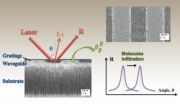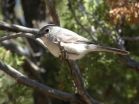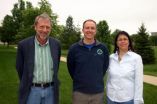(Press-News.org) WASHINGTON, May 26—Vanderbilt University engineers have created a "spongy" silicon biosensor that shows promise not only for medical diagnostics, but also for the detection of dangerous toxins and other tiny molecules in the environment. This innovation was originally designed to detect the presence of particular DNA sequences, which can be extremely helpful in identifying whether or not a person is predisposed to heart disease or certain kinds of cancer. The new sensor is described in the Optical Society's open access journal, Optics Express.
Biological chemical sensors save lives by detecting dangerous substances in the environment or specific molecules in the blood that could signal life-threatening diseases. Current sensor technologies, however, are limited because of their large size compared to the extremely minute sizes of some of the chemicals to be detected. In most cases, when attempting to sense something very small with a large sensor, the small molecules don't perturb the sensor's properties enough for detection.
As Vanderbilt University's Xing Wei, a graduate student, and Sharon M. Weiss, an associate professor of electrical engineering and physics, report in Optics Express, it's possible to eliminate this challenge by making sensors with features that are comparative in size to the molecules being detected, greatly increasing the sensitivity of current sensing technology.
To do this, the engineers turned to a porous silicon material, which acts essentially as a small sponge that can then be "seeded" or filled with all sorts of substances that change its properties—resulting in a detector that's highly sensitive to small molecules (See Figure 1). Capturing a particular sequence of DNA involves seeding the sensor with a single strand of DNA, so that only the complementary strand can attach to it and everything else gets rinsed away.
Why use a porous silicon material? Weiss and Wei stress the significance of their new sensor's enormous surface area relative to its small size. To illustrate this point, Weiss describes two cubes, one of which is 3 cm on a side, with a flat surface that DNA can be attached to—providing 54 cm2 of available surface area to attach these molecules. The other is an identical-size cube, made into a porous silicon sponge and with the ability to access the volume of the cube with all of the internal surface area, providing a surface area that is nearly 10,000 times greater than the first cube. This is like comparing the area of a golf ball to the area of a football field—with the same footprint (See Figure 2). "It's an enormous increase in the potential of how many molecules you can capture, and this is one reason why our new sensor is so much more sensitive for detecting small molecules," says Weiss.
And by using a "grating," a type of surface texturing of the porous silicon commonly used in sensors of this type, light can be delivered in a very simple and compact way to probe the change in the sensor's properties to determine whether or not any molecules of interest have been captured.
"If you look at a CD or a DVD in the light, you'll notice lots of colors bounce off it in room light. The way these discs work is that there are a bunch of bumps, which are very similar to our gratings," says Weiss. When light interacts with a particular arrangement of bumps, the engineers can essentially tell the light what to do, enabling readout of the music or videos on the disc.
That's precisely what the Vanderbilt team has done with their sensor—put bumps on top of it to control how the light interacts with their active sensing medium (the porous silicon "waveguide"). Then they can determine what the signal means based either on the color that comes out or by the angle of light as it exits the sensor.
"When we infiltrate the molecules that we want to detect and they stay in the sensor and attach, they change the optical density of the porous silicon and, consequently, the angle or the color of light that comes back out," Weiss elaborates. "By knowing how much the angle changes, for example, we can quantify how many molecules are present. So not only can we identify our DNA sequence or toxin, but we can also know how much is present as well. For diagnostics, it's very helpful to know how much is present."
Other potential applications beyond DNA sensing may include detecting small molecules—such as toxins in the environment—which has significant national security implications.
INFORMATION:
Paper: "Guided mode biosensor based on grating coupled porous silicon waveguide," Xing Wei and Sharon M. Weiss, Optics Express, Volume 19, Issue 12, pp. 11330-11339. http://www.opticsinfobase.org/oe/abstract.cfm?uri=oe-19-12-11330
About Optics Express
Optics Express reports on new developments in all fields of optical science and technology every two weeks. The journal provides rapid publication of original, peer-reviewed papers. It is published by the Optical Society and edited by C. Martijn de Sterke of the University of Sydney. Optics Express is an open-access journal and is available at no cost to readers online at http://www.OpticsInfoBase.org/OE.
About OSA
Uniting more than 106,000 professionals from 134 countries, the Optical Society (OSA) brings together the global optics community through its programs and initiatives. Since 1916 OSA has worked to advance the common interests of the field, providing educational resources to the scientists, engineers and business leaders who work in the field by promoting the science of light and the advanced technologies made possible by optics and photonics. OSA publications, events, technical groups and programs foster optics knowledge and scientific collaboration among all those with an interest in optics and photonics. For more information, visit www.osa.org.
Improving DNA sequencing: Sponge-like biosensor crams enormous power into tiny space
New silicon sensor described in Optics Express has promising medical, security applications
2011-05-27
ELSE PRESS RELEASES FROM THIS DATE:
AsiaRooms.com - Singapore Open Super Series 2011 Starts in June
2011-05-27
Next month will see some of the top badminton players in the world congregate for the Singapore Open Super Series 2011.
Running from June 14th to 19th, the event is one of the highlights of the country's badminton calendar.
It takes place at the Singapore Indoor Stadium and will give attendees the chance to see the best players on the domestic scene take on international stars.
Some names to watch out for are Danny Bawa Christnanta, Vannessa Neo and Hendra Wijaya. They all came home from the recent Li Ning New Zealand International Challenge 2011 with trophies.
Christnanta ...
San Diego Daily Deals Site Sets Record
2011-05-27
San Diego's leading news site SignOnSanDiego.com recently partnered with digital agency Cuker Interactive to redesign Daily Deals, a service featuring deals of up to 90 percent off of local restaurants, attractions, and services. Located at http://dailydeal.signonsandiego.com, the program allows users to sign up to receive email notifications for daily deals, share them with friends and family, and earn credits for referral purchases. Since the site launched in March, the Daily Deals site has generated significant revenue, including a record-setting $366,035 through a single ...
Factors in berry-splitting in blueberries examined
2011-05-27
This release is available in Spanish.
U.S. Department of Agriculture (USDA) researchers and a university colleague have found several factors involved in blueberry splitting, a significant problem that can cause losses of $300 to $500 per acre.
Splitting and cracking occur in southern highbush and rabbiteye blueberries if they receive preharvest rainfall when fully ripe or approaching ripeness, according to scientists with USDA's Agricultural Research Service (ARS). ARS is USDA's principal intramural scientific research agency.
ARS horticulturist Donna Marshall, retired ...
Diabetes can be predicted 7 years before pregnancy with blood sugar and body weight
2011-05-27
OAKLAND, Calif. — A woman's risk of developing diabetes during pregnancy can be identified up to seven years before she becomes pregnant based on routinely assessed measures of blood sugar and body weight, according to a Kaiser Permanente study published in the online issue of the American Journal of Obstetrics and Gynecology.
Researchers at the Kaiser Permanente Division of Research in Oakland, Calif., studied 580 ethnically diverse women who took part in a multiphasic health checkup at Kaiser Permanente Northern California between1984 and 1996. The researchers looked ...
Songbirds tweak their tunes in different ways to cope with clamor
2011-05-27
AUDIO:
Listen to a plumbeous vireo singing in a quiet area. This was recorded by lead author Clinton Francis of the National Evolutionary Synthesis Center.
Click here for more information.
Durham, NC — Some birds that live near noisy sites can alter their songs to deal with din. But closely related species with similar songs may tweak their tunes in different ways, says a new study led by Clinton Francis of the National Evolutionary Synthesis Center in Durham, NC.
The ...
White Digital Media Announces Sasha Orman as Content Director of Food and Drink Digital
2011-05-27
White Digital Media (WDM), the leading digital business news source for C-level executives, recently announced Sasha Orman, former staff writer for Exec Digital, as the Content Director of Food and Drink Digital - one of White Digital Media's leading brands. Food and Drink Digital serves as one of WDM's nine industry sector brands, providing the latest business news to executives and professionals working in the food and beverage industry worldwide.
"I'm definitely excited to take on the responsibility of Content Director of Food and Drink Digital," explains ...
Stanford scientists turn human skin cells directly into neurons, skipping IPS stage
2011-05-27
STANFORD, Calif. — Human skin cells can be converted directly into functional neurons in a period of four to five weeks with the addition of just four proteins, according to a study by researchers at the Stanford University School of Medicine. The finding is significant because it bypasses the need to first create induced pluripotent stem cells, and may make it much easier to generate patient- or disease-specific neurons for study in a laboratory dish.
It may also circumvent a recently reported potential problem with iPS cells, in which laboratory mice rejected genetically ...
Researchers track the secret lives of feral and free-roaming house cats
2011-05-27
CHAMPAIGN, lll. — Researchers (and some cat-owners) wanted to know: What do feral and free-roaming house cats do when they're out of sight? A two-year study offers a first look at the daily lives of these feline paupers and princes, whose territories overlap on the urban, suburban, rural and agricultural edges of many towns.
The study used radio telemetry and a sophisticated activity-tracking device to capture the haunts and habits of dozens of owned and un-owned cats living at the southern edge of Champaign and Urbana, neighboring cities in Central Illinois. Together, ...
White Digital Media's Social Media Guru Robert Rosales Steps into Coordinating Role
2011-05-27
White Digital Media, the leading digital business news source for C-level executives across the globe, announced today the promotion of Robert Rosales, former Social Media Coordinator, to Marketing Coordinator. After tremendous success in managing the social media channels for each of White Digital Media's brands, Rosales proved that he was ready to take on greater responsibility within the Marketing department and within the company as a whole.
"I am proud to have contributed to the success of our growing company," said Rosales. "I welcome the opportunity ...
Ken George, CEO of York Care Center, Reveals the Secrets to Delivering a Culture of Excellence with Business Review USA
2011-05-27
In an interview with Business Review Canada, Ken George, CEO of York Care Center discusses how the facility built a reputation in aging care by focusing on education, knowledge transfer and character.
By operating under the principle that this sector of the industry deserves more consideration, York Care Centre demonstrates excellence and has followed the lead of other health care organizations that have been credentialed as Magnet organizations. "We believe that it's time to breathe some life into this business. These folks deserve better than what's left over ...
LAST 30 PRESS RELEASES:
Brain stimulation device cleared for ADHD in the US is overall safe but ineffective
Scientists discover natural ‘brake’ that could stop harmful inflammation
Tougher solid electrolyte advances long-sought lithium metal batteries
Experts provide policy roadmap to reduce dementia risk
New 3D imaging system could address limitations of MRI, CT and ultrasound
First-in-human drug trial lowers high blood fats
Decades of dredging are pushing the Dutch Western Scheldt Estuary beyond its ecological limits
A view into the innermost workings of life: First scanning electron microscope with nanomanipulator inaugurated in hesse at Goethe University
Simple method can enable early detection and prevention of chronic kidney disease
S-species-stimulated deep reconstruction of ultra-homogeneous CuS nanosheets for efficient HMF electrooxidation
Mechanical and corrosion behavior of additively manufactured NiTi shape memory alloys
New discovery rewrites the rules of antigen presentation
Researchers achieve chain-length control of fatty acid biosynthesis in yeast
Water interactions in molecular sieve catalysis: Framework evolution and reaction modulation
Shark biology breakthrough: Study tracks tiger sharks to Maui mating hub
Mysterious iron ‘bar’ discovered in famous nebula
World-first tool reduces harmful engagement with AI-generated explicit images
Learning about public consensus on climate change does little to boost people’s support for action, study shows
Sylvester Cancer Tip Sheet for January 2026
The Global Ocean Ship-Based Hydrographic Investigations Program (GO-SHIP) receives the Ocean Observing Team Award
Elva Escobar Briones selected for The Oceanography Society Mentoring Award
Why a life-threatening sedative is being prescribed more often for seniors
Findings suggest that certain medications for Type 2 diabetes reduce risk of dementia
UC Riverside scientists win 2025 Buchalter Cosmology Prize
SETI Institute opens call for nominations for the 2026 Tarter Award
Novel theranostic model shows curative potential for gastric and pancreatic tumors
How beige fat keeps blood pressure in check
Fossils reveal ‘latitudinal traps’ that increased extinction risk for marine species
Review: The opportunities and risks of AI in mental health research and care
New map reveals features of Antarctic’s ice-covered landscape
[Press-News.org] Improving DNA sequencing: Sponge-like biosensor crams enormous power into tiny spaceNew silicon sensor described in Optics Express has promising medical, security applications




